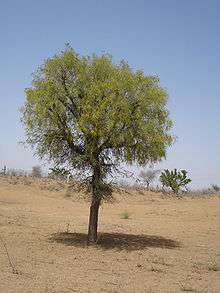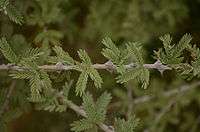Prosopis cineraria
| Prosopis cineraria | |
|---|---|
 | |
| Scientific classification | |
| Kingdom: | Plantae |
| (unranked): | Angiosperms |
| (unranked): | Eudicots |
| (unranked): | Rosids |
| Order: | Fabales |
| Family: | Fabaceae |
| Genus: | Prosopis |
| Species: | P. cineraria |
| Binomial name | |
| Prosopis cineraria | |
| Synonyms | |
|
Adenanthera aculeata Roxb.[1] | |
Prosopis cineraria, known as Jammi, Shami, Khejri Tree, or Ghaf, is a species of flowering tree in the pea family, Fabaceae. It is native to arid portions of Western Asia and the Indian Subcontinent, including Afghanistan, Bahrain, Iran, India, Oman, Pakistan, Saudi Arabia, the United Arab Emirates and Yemen. It is an established introduced species in parts of Southeast Asia, including Indonesia.[1]
It is the national tree of the United Arab Emirates, where it is known as Ghaf. Through the Give a Ghaf campaign its citizens are urged to plant it in their gardens to combat desertification and to preserve their country's heritage.[3] The desert village of Nazwa in the UAE is home to the Al Ghaf Conservation Reserve.[4]
It is also the state tree of Rajasthan, where it is known as Khejri, and Telangana in India. A large and well-known example of the species is the Tree of Life in Bahrain – approximately 400 years old and growing in a desert devoid of any obvious sources of water.
In 1730 AD, the village of Khejarli near Jodhpur in Rajasthan was the scene of a violent environmental confrontation. Amrita Devi and her three young daughters gave their lives in an attempt to protect some Khejri trees which Maharaja Abhay Singh had ordered cut to make way for his new palace. This led to widespread defiance in which 363 people were killed trying to save the trees. In the 1970s memory of this sacrifice led to the start of the Chipko movement. [5]
Description

P. cineraria is a small tree, ranging in height from 3–5 m (9.8–16.4 ft). Leaves are bipinnate, with seven to fourteen leaflets on each of one to three pinnae. Branches are thorned along the internodes. Flowers are small and creamy-yellow, and followed by seeds in pods. The tree is found in extremely arid conditions, with rainfall as low as 15 cm (5.9 in) annually; but is indicative of the presence of a deep water table. As with some other Prosopis spp., P. cineraria has demonstrated a tolerance of highly alkaline and saline environments.[6]
The tree is not to be confused with the similar looking Chinese lantern tree (Dichrostachys cinerea), which can be told apart by its flowers. While the Chinese lantern tree has bicolored pink-yellow flowers, the true Shami tree only has plain-yellow bristled flowers like most other mesquites.
Religious significance
This tree, called Shami, is highly revered among Hindus and worshipped as part of Dasahra festival.[7] This tree takes importance during the tenth day of Dasara Festival when it is worshipped in various parts of India. Historically among Rajputs, the ranas, who were the high priest and the king, used to perform the worship and then they used to liberate a jay which was considered the sacred bird of Lord Rama.[8][9] In the Deccan, as part of the tenth day ritual of Dasara, the marathas used to shoot arrows on to the leaf of the tree and gather the falling leaf into their turbans as a custom.[10][9]
The tree is known by different names across the western and northern regions of India, e.g. Shami in Maharastra, Jammi in Telngana, Khijro in Gujarat, Khejri in Rajasthan, Janti in Haryana and Jand in Punjab.
In Karnataka, Acacia ferruginea has also been locally referred to as Banni mara in place of the accepted Khejri tree and erroneously accepted as the tree where the Pandavas hid their weapons during exile.[11] There are also some unconfirmed references which consider Acacia ferruginea as the tree which is revered and worshipped on Vijay-Dashami day.[12] However as per historical references, Prosopis cineraria is the tree which is known as the Banni mara [13][14][15][16][17][18][19][20] and is also the tree which holds a special place in the Mysore Dasara where its worshipped on the Vijay-dashami day.[13][14][15][17][19][21][22]
In the Mahabharata, the Pandavas are known to have spent their thirteenth year of exile in disguise in the kingdom of Virata. Before going to Virata, they are known to have hung their celestial weapons in this tree for safe keeping for a year. When they returned after a year, they found their weapons safe in the branches of the Shami tree. Before taking the weapons, they worshipped the tree and thanked it for keeping their weapons safe.[23][9][20][13][19][22]
See also
References
- 1 2 3 "Prosopis cineraria (L.) Druce". Catalogue of Life. Integrated Taxonomic Information System and Species2000. 2012-03-15. Retrieved 2012-03-21.
- ↑ "Prosopis cineraria". Germplasm Resources Information Network (GRIN). Agricultural Research Service (ARS), United States Department of Agriculture (USDA). Retrieved 2009-12-31.
- ↑ Philp, Myra (2013-06-17). "UAE groups help to save ghaf trees on UN 'Combat Desertification Day'". 7DAYS in Dubai. Al Sidra Media. Archived from the original on 2013-10-12. Retrieved 2018-03-21.
- ↑ "Six natural reserves declared in Dubai". The National. Retrieved 2018-09-09.
- ↑ https://indianexpress.com/article/research/khejri-the-tree-that-inspired-chipko-movement-is-dying-a-slow-death-4409701/
- ↑ "Prosopis cineraria (L.) Druce". Tropical Forages. Centre for International Agriculture Research and Food and Agriculture Agency. 2005. Retrieved 2012-03-21.
- ↑ S.M, Edwardes; S.M, Edwards (March 1922). "Tree-Worship in India". Empire Forestry Journal. 1 (1): 85. JSTOR 42594479.
- ↑ W, Crooke (1915). "The Dasahra: An Autumn Festival of Hindus". Folklore. 26 (1): 29–30. doi:10.1080/0015587X.1915.9719701.
- 1 2 3 Gandhi, Maneka; Singh, Yasmeen (1989). Brahma's hair - Mythology of indian plants. New Delhi: Rupa & co. pp. 29–32. ISBN 81-7167-005-9.
- ↑ W, Crooke (1915). "The Dasahra: An Autumn Festival of Hindus". Folklore. 26 (1): 36–37. doi:10.1080/0015587X.1915.9719701.
- ↑ Babu NM, Ganesh. "Tree that hid pandavas' weapons when they were in exile". The New Indian Express.
- ↑ S.G, Neginhal (2011). Forest Trees of the Western Ghats. S.G Neginhal. p. 133. ISBN 9789350671733.
- 1 2 3 S Sivapriyananda (1995). Mysore Royal Dasara. Abhinav Publications. pp. 51, 55.
- 1 2 L., Krishna Anantha Krishna Iyer (Diwan Bahadur); Nanjundayya, Hebbalalu Velpanuru (Diwan Bahadur); H.V, Nanjundayya (1935). The Mysore tribes and castes. Pub. under the auspices of the Mysore University. p. 68.
- 1 2 Fuller, Christopher John (2004). The Camphor Flame: Popular Hinduism and Society in India. Princeton University Press. p. 121. ISBN 069112048X.
- ↑ Claus, Peter; Diamond, Sarah; Mills, Margaret (2003). South Asian Folklore: An Encyclopedia (Special -Reference). p. 536. ISBN 0415939194.
- 1 2 Parsons, Constance (1930). Mysore City. Humphery Milford Oxford University Press. p. 184.
- ↑ "The Quarterly Journal of the Mythic Society". Mythic Society. 32 (1): 309. 1941.
- 1 2 3 Milton, Lawrence. "Why Dasara procession culminates at Bannimantap". Times of India.
- 1 2 Thurston, Edgar; K, Rangachari (1909). Castes and Tribes of Southern India. p. 147.
- ↑ Smaranananda, Swami (2001). Prabuddha Bharata: Or Awakened India. Volume 106. p. 49.
- 1 2 Bharata, Prabuddha. "Mysore Dasara - A Living Tradition". Archived from the original on 2007-03-07.
- ↑ Krishna, Nanditha; M, Amirthalingam (2014). Sacred Plants of India (first ed.). Penguin books india 2014. pp. 171–175. ISBN 9780143066262.
External links
| Wikimedia Commons has media related to Prosopis cineraria. |
- The wonders of the ‘wonder tree’, Tribune India
- Meet the Ghaf Tree